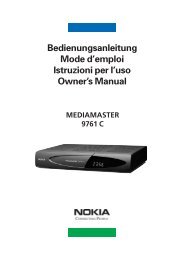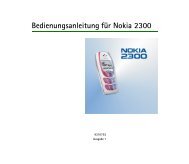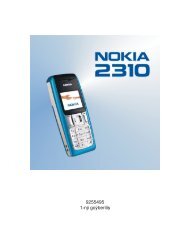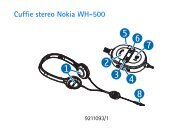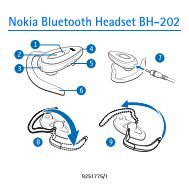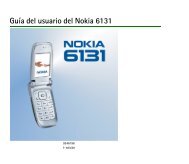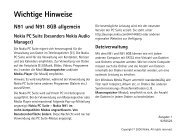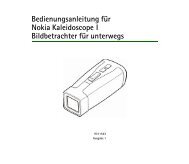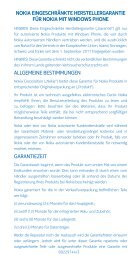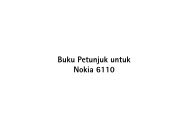Additional Applications - Nokia
Additional Applications - Nokia
Additional Applications - Nokia
You also want an ePaper? Increase the reach of your titles
YUMPU automatically turns print PDFs into web optimized ePapers that Google loves.
<strong>Additional</strong><br />
<strong>Applications</strong><br />
<strong>Nokia</strong> N93i-1
ABOUT ADD-ON APPLICATIONS FOR YOUR NOKIA N93i<br />
In the memory of your device and on the DVD-ROM supplied with the device you<br />
will find additional applications from <strong>Nokia</strong> and third-party developers.<br />
NO WARRANTY<br />
The third-party applications provided with your device may have been created and<br />
may be owned by persons or entities not affiliated with or related to <strong>Nokia</strong>. <strong>Nokia</strong><br />
does not own the copyrights or intellectual property rights to these third-party<br />
applications. As such, <strong>Nokia</strong> does not take responsibility for any end-user support,<br />
functionality of the applications, or the information in the applications or these<br />
materials. <strong>Nokia</strong> does not provide any warranty for the third-party applications.<br />
BY USING THE APPLICATIONS YOU ACKNOWLEDGE THAT THE APPLICATIONS ARE<br />
PROVIDED AS IS WITHOUT WARRANTY OF ANY KIND EXPRESS OR IMPLIED AND<br />
TO THE MAXIMUM EXTENT PERMITTED BY APPLICABLE LAW. NEITHER NOKIA NOR<br />
ITS AFFILIATES MAKE ANY REPRESENTATIONS OR WARRANTIES, EXPRESS OR<br />
IMPLIED, INCLUDING BUT NOT LIMITED TO WARRANTIES OF TITLE,<br />
MERCHANTABILITY OR FITNESS FOR A PARTICULAR PURPOSE OR THAT THE<br />
SOFTWARE WILL NOT INFRINGE ANY THIRD-PARTY PATENTS, COPYRIGHTS,<br />
TRADEMARKS, OR OTHER RIGHTS.<br />
© 2007 <strong>Nokia</strong>. All rights reserved.<br />
<strong>Nokia</strong> and <strong>Nokia</strong> Connecting People, Nseries, and N93i are registered trademarks<br />
of <strong>Nokia</strong> Corporation. Other product and company names mentioned herein may<br />
be trademarks or trade names of their respective owners.<br />
<strong>Nokia</strong> operates a policy of ongoing development. <strong>Nokia</strong> reserves the right to make<br />
changes and improvements to any of the products described in this document<br />
without prior notice.<br />
TO THE MAXIMUM EXTENT PERMITTED BY APPLICABLE LAW, UNDER NO<br />
CIRCUMSTANCES SHALL NOKIA OR ANY OF ITS LICENSORS BE RESPONSIBLE FOR<br />
ANY LOSS OF DATA OR INCOME OR ANY SPECIAL, INCIDENTAL, CONSEQUENTIAL<br />
OR INDIRECT DAMAGES HOWSOEVER CAUSED.<br />
THE CONTENTS OF THIS DOCUMENT ARE PROVIDED "AS IS". EXCEPT AS REQUIRED<br />
BY APPLICABLE LAW, NO WARRANTIES OF ANY KIND, EITHER EXPRESS OR<br />
IMPLIED, INCLUDING, BUT NOT LIMITED TO, THE IMPLIED WARRANTIES OF<br />
MERCHANTABILITY AND FITNESS FOR A PARTICULAR PURPOSE, ARE MADE IN<br />
RELATION TO THE ACCURACY, RELIABILITY OR CONTENTS OF THIS DOCUMENT.<br />
NOKIA RESERVES THE RIGHT TO REVISE THIS DOCUMENT OR WITHDRAW IT AT ANY<br />
TIME WITHOUT PRIOR NOTICE.<br />
The availability of particular products and applications for these products may vary<br />
by region. Please check with your <strong>Nokia</strong> dealer for details, and availability of<br />
language options.<br />
Some operations and features are SIM card and/or network dependent, MMS<br />
dependent, or dependent on the compatibility of devices and the content formats<br />
supported. Some services are subject to a separate charge.<br />
ISSUE 2 EN, 9254463
Contents<br />
Introduction ...............................................4<br />
Network services.................................................................... 4<br />
Support..................................................................................... 4<br />
Internet.......................................................6<br />
Download! .............................................................................. 6<br />
Mobile Search ...........................................8<br />
Use Mobile Search ................................................................ 8<br />
More information.................................................................. 8<br />
Tools ...........................................................9<br />
Settings wizard ..................................................................... 9<br />
Connectivity ............................................ 11<br />
Push to talk ..........................................................................11<br />
Positioning.............................................................................15<br />
Gallery...................................................... 19<br />
Print online............................................................................19<br />
Share online..........................................................................20<br />
For your PC.............................................. 23<br />
Home Media Server ...........................................................23<br />
<strong>Nokia</strong> Lifeblog .....................................................................24<br />
<strong>Nokia</strong> PC Suite ....................................................................27<br />
Adobe Photoshop Album Starter Edition ....................28<br />
Adobe Premiere Elements ................................................31
Introduction<br />
4<br />
Introduction<br />
Model number: <strong>Nokia</strong> N93i-1<br />
Hereinafter referred to as <strong>Nokia</strong> N93i.<br />
Your <strong>Nokia</strong> N93i is a powerful, intelligent multimedia<br />
device. There are various applications provided by <strong>Nokia</strong><br />
and different third-party software developers to help you<br />
do more with your <strong>Nokia</strong> N93i.<br />
Some of the applications provided are in the device<br />
memory, and some are on the DVD-ROM supplied with the<br />
device.<br />
To use some applications, you must accept the applicable<br />
license terms.<br />
Throughout this document, icons indicate if the<br />
application is available in the device memory ( ) or on<br />
the DVD-ROM ( ).<br />
You must install the applications on the<br />
DVD-ROM to a compatible PC before using them.<br />
Refer to the user guide for other important information<br />
about your device.<br />
Copyright protections may prevent some images, music<br />
(including ringing tones), and other content from being<br />
copied, modified, transferred, or forwarded.<br />
Network services<br />
To use the device you must have service from a wireless<br />
service provider. Many of the features require special<br />
network features. These features are not available on all<br />
networks; other networks may require that you make<br />
specific arrangements with your service provider before<br />
you can use the network services. Your service provider<br />
can give you instructions and explain what charges will<br />
apply. Some networks may have limitations that affect<br />
how you can use network services. For instance, some<br />
networks may not support all language-dependent<br />
characters and services.<br />
Your service provider may have requested that certain<br />
features be disabled or not activated in your device. If so,<br />
these features will not appear on your device menu. Your<br />
device may also have a special configuration such as<br />
changes in menu names, menu order, and icons. Contact<br />
your service provider for more information.<br />
Support<br />
<strong>Applications</strong> provided by third-party software developers<br />
are supported by these developers. If you experience
problems with an application, obtain support from the<br />
relevant website. See the web links at the end of each<br />
application in this guide.<br />
Introduction<br />
5
Internet<br />
6<br />
Internet<br />
Download!<br />
Download! (network service) is a mobile content shop<br />
available on your device.<br />
With Download! you can discover; preview; buy;<br />
download, and upgrade content, services, and<br />
applications that work with your <strong>Nokia</strong> device. Games,<br />
ringing tones, wallpaper, applications, and much more are<br />
easily accessible. The items are categorized under catalogs<br />
and folders provided by different service providers. The<br />
available content depends on your service provider.<br />
Press , and select Internet > Download!.<br />
Download! uses your network services to access the most<br />
up-to-date content. For information on additional items<br />
available through Download!, contact your service<br />
provider, or the supplier or manufacturer of the item.<br />
Download! receives ongoing updates, and provides you<br />
with the latest content your service provider offers for<br />
your device. To update the content in Download!<br />
manually, select Options > Refresh list.<br />
To hide a folder or a catalog from the list (for example, to<br />
view only the items you use frequently), select Options ><br />
Hide. To make all the hidden items visible again, select<br />
Options > Show all.<br />
To buy the selected item in the main view, a folder, or a<br />
catalog, select Options > Buy. A submenu opens where<br />
you can select the version of the item and view price<br />
information. The available options depend on the service<br />
provider.<br />
To download an item that is free of charge, select<br />
Options > Get.<br />
Settings<br />
The application updates your device with the most recent<br />
content available from your service provider and other<br />
available channels. To change the settings, select<br />
Options > Settings and from the following:<br />
Access point—to select which access point is used to<br />
connect to the service provider’s server and whether to<br />
have the device to ask for the access point every time you<br />
use it
Automatic open—Select Yes if you want the content or<br />
application to be opened automatically after downloading.<br />
Preview confirmation—Select No if you want to<br />
automatically download a preview of the content or<br />
application. Select Yes if you want to be asked separately<br />
each time before downloading a preview.<br />
Buy confirmation—Select Yes if you want to be asked for<br />
confirmation before buying content or an application. If<br />
you select No the buying process starts immediately after<br />
you select Buy.<br />
After you complete the settings, select Back.<br />
Internet<br />
7
Mobile Search<br />
8<br />
Mobile Search<br />
Use Mobile Search to get access to search engines, and<br />
find and connect to local services, websites, images, and<br />
mobile content. You can use the application to find and<br />
call local restaurants and shops, and use the advanced<br />
mapping technology to assist you in finding their location.<br />
Use Mobile Search<br />
Press , and select Search.<br />
When you open Mobile Search, a list of categories is<br />
displayed. Select a category (for example, images), and<br />
enter your text into the search field. Select Search. The<br />
search results are displayed<br />
More information<br />
For additional help and instructions on the application,<br />
select Options > Help.<br />
For more information on the application, visit also<br />
www.mobilesearch.nokia.com/.
Tools<br />
Settings wizard<br />
Press , and select Tools > Sett. wizard.<br />
Settings wizard configures your device for operator, email,<br />
push-to-talk, and video sharing settings based on<br />
your service provider information.<br />
The availability of different settings in Settings wizard<br />
depends on the features of your device, SIM card, operator,<br />
and availability of the data in the settings wizard database<br />
in the device memory.<br />
To use these services, you may have to contact your service<br />
provider to activate a data connection or other services.<br />
When you use the application for the first time, you are<br />
guided through the settings configuration. To start the<br />
wizard, select Start. To cancel the operation, select Exit.<br />
If you do not have a SIM card inserted, you are asked to<br />
select the home country of your operator and your<br />
operator. If the country or operator suggested by the<br />
wizard is not the correct one, select one from the list.<br />
To access the main view of Settings wizard after the<br />
settings configuration, select OK. If the settings<br />
configuration is interrupted, the settings are not defined.<br />
After closing the wizard you can start to use the<br />
configured applications in their own menu locations.<br />
E-mail<br />
When you choose to configure your e-mail settings,<br />
Settings wizard asks you to enter: e-mail address,<br />
mailbox name, user name, and password.<br />
If the e-mail service provider you entered is unknown, the<br />
wizard asks you to define the mailbox type and incoming<br />
and outgoing mail servers. Contact your service provider<br />
for more information.<br />
To start using the new mailbox after entering the required<br />
information, select Yes, or select No to return to the<br />
Settings wizard main view.<br />
Operator<br />
When you choose to configure your operator settings,<br />
Settings wizard asks you to select from the available<br />
settings, then OK.<br />
Tools<br />
9
Tools<br />
10<br />
Push to talk<br />
This option is available only if you have the application<br />
installed in your device, and you have subscribed to the<br />
service.<br />
When you choose to configure your push-to-talk (PTT)<br />
(network service) settings, Settings wizard asks you to<br />
define: PTT nickname, user name, and password.<br />
Video sharing<br />
This option is available only if you have the application<br />
installed in your device and you have subscribed to the<br />
service.<br />
To be able to make a video call, you must have a USIM<br />
card and be in coverage of a UMTS network.<br />
When you choose to configure your video sharing<br />
(network service) settings, Settings wizard asks you to<br />
enter: video sharing address, user name, password, video<br />
sharing proxy user name, and password; and select OK.<br />
After creating video sharing settings, Settings wizard<br />
asks if you want to add the video sharing address to a<br />
contact. Select Yes or No.<br />
More information<br />
If you experience any problems with Settings wizard, visit<br />
the <strong>Nokia</strong> phone settings website at<br />
www.nokia.com/phonesettings.
Connectivity<br />
Push to talk<br />
Push to talk (PTT) (network service) is a real-time voice<br />
over IP service implemented over a packet data network.<br />
PTT provides direct voice communication connected with<br />
the push of a key. Use PTT to have a conversation with one<br />
person or with a group of people.<br />
Before you can use PTT, you must define the PTT access<br />
point and PTT settings. You may receive the settings in a<br />
special text message from the service provider that offers<br />
the PTT service. You can also use Settings wizard for<br />
configuration if supported by your service provider. See<br />
‘Settings wizard’, p. 9.<br />
Press , and select Connect. > PTT.<br />
In PTT communication, one person talks while the others<br />
listen through the built-in loudspeaker. Speakers take<br />
turns responding to each other. Because only one group<br />
member can talk at any time, the maximum duration of<br />
each turn is limited. The maximum duration is usually set<br />
to 30 seconds. For details of the duration for your network,<br />
contact your service provider.<br />
Warning: Do not hold the device near your ear<br />
when the loudspeaker is in use, because the volume<br />
may be extremely loud.<br />
Phone calls always take priority over PTT activities.<br />
Define a PTT access point<br />
Many service providers require you to use an internet<br />
access point (IAP) for your default access point. Other<br />
service providers allow you to use a WAP access point.<br />
Contact your service provider for more information.<br />
If you do not have a WAP connection, you may need to<br />
contact your service provider for assistance with the<br />
first-time connection or visit<br />
www.nokia.com phonesettings.<br />
PTT settings<br />
Press , and select Connect. > PTT > Options ><br />
Settings.<br />
Select User settings, and enter the following information:<br />
Incoming PTT calls—Select Notify if you want to see a<br />
notification of incoming calls. Select Auto-accept if you<br />
Connectivity<br />
11
Connectivity<br />
12<br />
want PTT calls to be answered automatically. Select Not<br />
allowed if you want PTT calls to be rejected automatically.<br />
PTT call alert tone—Select Set by profile if you want the<br />
incoming call alert setting for PTT to be the same as the<br />
incoming call alert tone defined in the prevailing active<br />
profile.<br />
Callback request tone—Select a tone for callback<br />
requests.<br />
Application start-up—Select if you want to log in to the<br />
PTT service when you switch on your device.<br />
Default nickname—Enter your default nickname that is<br />
displayed to other users. Your service provider may have<br />
disabled the editing of this option in your device.<br />
Show my PTT address—Select In 1 to 1 calls, In group<br />
calls, In all calls, or Never. Your service provider may have<br />
disabled some of these options in your device.<br />
Show my login status—Select Yes if you want your status<br />
to be shown or No if you want your status to be hidden.<br />
Select Connection settings, and enter the following<br />
information:<br />
Domain—Enter the domain name obtained from your<br />
service provider.<br />
Access point name—Enter the PTT access point name. The<br />
access point name is needed to establish a connection to<br />
the GSM/GPRS network.<br />
Server address—Enter the IP address or domain name of<br />
the PTT server obtained from your service provider.<br />
User name—Enter your user name obtained from your<br />
service provider.<br />
Password—Enter a password, if required, to make a data<br />
connection. The password is usually provided by the service<br />
provider and is often case-sensitive.<br />
Log in to PTT<br />
Press , and select Connect. > PTT. PTT automatically<br />
logs in to the service when started.<br />
When log in is successful, push to talk automatically<br />
connects to channels that were active when the<br />
application was last closed. If the connection is lost, the<br />
device automatically tries to log back in until you choose<br />
to exit PTT.<br />
Exit PTT<br />
Press , and select Connect. > PTT > Options > Exit.<br />
Switch Push to talk off after exiting application? is<br />
displayed. Select Yes to log out and close the service.<br />
Select No if you want to keep the application active in the
ackground. If several applications are open and you want<br />
to switch from one application to another, press and hold<br />
.<br />
Make a one-to-one call<br />
Select Options > PTT contacts.<br />
Select the contact you want to talk to from the list, and<br />
select Options > Talk 1 to 1.<br />
Press and hold the entire time you are talking. When<br />
you have finished talking, release .<br />
To talk to the contact, press and hold also in other<br />
views in the PTT application (for example, the contacts<br />
view). To make a new phone call, end the one-to-one call.<br />
Select Disconnect, or press .<br />
Tip! Remember to hold the device in front of you<br />
during a PTT call so you can see the display. Speak<br />
towards the microphone, and do not cover the<br />
loudspeaker with your hands.<br />
Answer a one-to-one call<br />
Press to start a one-to-one call or to dismiss the<br />
call.<br />
Make a group call<br />
To call a group, select Options > PTT contacts, mark the<br />
contacts you want to call, and select Options > Make PTT<br />
group call.<br />
Tip! You can make a one-to-one or group call also<br />
from Contacts. Select Options > PTT Options ><br />
Create 1 to 1 call or Create group call.<br />
Subscribe login status of others<br />
To subscribe or unsubscribe to the PTT login status of<br />
others, select Options > PTT contacts, the contact, and<br />
Options > Show login status or Hide login status.<br />
Send a callback request<br />
In PTT contacts, scroll to the desired name, and select<br />
Options > Send callback request.<br />
Respond to a callback request<br />
When someone sends you a callback request, 1 new<br />
callback request is displayed. Select Show > Callback<br />
inbox, a contact, and Options > Talk 1 to 1 to start a<br />
one-to-one call.<br />
Connectivity<br />
13
Connectivity<br />
14<br />
Channels<br />
You can join public preconfigured channels. Public<br />
channels are open to anyone who knows the URL for the<br />
channel.<br />
When you are connected to a channel and talk, all<br />
members joined to the channel hear you talking. Up to five<br />
channels can be active at the same time. When more than<br />
one channel is active, use Swap to change the channel.<br />
Select Options > PTT channels.<br />
To connect to a public preconfigured channel for the first<br />
time, select Options > New channel > Add existing.<br />
When you join a preconfigured channel, you must fill in a<br />
URL for the channel.<br />
Create your own channels<br />
To create a new preconfigured channel, select Options ><br />
New channel > Create new.<br />
You can create your own public channels, choose your<br />
own channel name, and invite members. Those members<br />
can invite more members to the public channel.<br />
You may also set up private channels. Only users invited<br />
by the host are allowed to join and use private channels.<br />
For each channel, define: Channel name, Channel<br />
privacy, Nickname in channel, and Channel thumbnail<br />
(optional).<br />
When you have successfully created a channel, you are<br />
asked if you want to send channel invitations. Channel<br />
invitations are text messages.<br />
Talk to a channel<br />
To talk to a channel after you log in to the PTT service,<br />
press . You hear a tone indicating that access is<br />
granted.<br />
Continue to press and hold while you talk. When you<br />
finish talking, release .<br />
If you respond to a channel by pressing while another<br />
member is talking, Wait is displayed. Release , wait for<br />
the other person to finish talking, and press again.<br />
Alternatively, press and hold until Talk is displayed.<br />
When you are talking in a channel, the first person to press<br />
when someone stops talking talks next.<br />
When you finish the PTT call, select Disconnect or press<br />
.<br />
To view currently active members of a channel when you<br />
have an active call to the channel, select Options > Active<br />
members.<br />
Open the invitation view and invite new members to a<br />
channel when you are connected to it, select Options ><br />
Send invitation. You can only invite new members when<br />
you are the host of a private channel or when the channel<br />
is a public channel. Channel invitations are text messages.
Respond to a channel invitation<br />
To save a received channel invitation, select Options ><br />
Save PTT channel. The channel is added to the channel<br />
view of your PTT contacts.<br />
After you save the channel invitation, you are asked if you<br />
want to connect to the channel. Select Yes to open the PTT<br />
sessions view. Your device logs in to the service if you are<br />
not logged in already.<br />
If you reject or clear the invitation, the invitation is stored<br />
in your messaging inbox. To join the channel later, open<br />
the invitation message, and save the invitation. Select Yes<br />
from the dialog to connect to the channel.<br />
View the PTT log<br />
Press , and select Connect. > PTT > Options > PTT log<br />
> Missed calls, Received calls, or Created calls.<br />
To start a one-to-one call from PTT log, press .<br />
Positioning<br />
Press , and select Connect. > Navigator or Landmarks.<br />
Some of the features in Landmarks and Navigator may<br />
require that you use a compatible GPS receiver.<br />
To start using a compatible GPS receiver with Bluetooth<br />
connectivity for positioning, select Connect. > Bluetooth.<br />
Use the Bluetooth connectivity to connect to the GPS<br />
receiver. For more information on using Bluetooth<br />
connectivity, see the user guide for your device.<br />
The Global Positioning System (GPS) is operated by the<br />
government of the United States, which is solely<br />
responsible for its accuracy and maintenance. The<br />
accuracy of location data can be affected by adjustments<br />
to GPS satellites made by the United States government<br />
and is subject to change with the United States<br />
Department of Defense civil GPS policy and the Federal<br />
Radionavigation Plan. Accuracy can also be affected by<br />
poor satellite geometry. Availability and quality of GPS<br />
signals may be affected by your location, buildings,<br />
natural obstacles, and weather conditions. The GPS<br />
receiver should only be used outdoors to allow reception<br />
of GPS signals.<br />
A GPS terminal receives low-power radio signals from the<br />
satellites, and measures the travel time of the signals.<br />
From the travel time, the GPS receiver can calculate its<br />
location to the accuracy of meters.<br />
The coordinates in the GPS are expressed in degrees and<br />
decimal degrees format using the international WGS-84<br />
coordinate system.<br />
Connectivity<br />
15
Connectivity<br />
16<br />
GPS should only be used as a navigation aid. It should not<br />
be used for precise location measurement and you should<br />
never rely solely on location data from the GPS receiver<br />
for positioning or navigation.<br />
About satellite signals<br />
If your GPS receiver cannot find the satellite signal,<br />
consider the following:<br />
• If you are indoors, go outdoors to receive a better<br />
signal.<br />
If you are outdoors, move to a more open space.<br />
If the weather conditions are bad, in such a case the<br />
signal strength may also be affected.<br />
Establishing a GPS connection may take from a couple<br />
of seconds to several minutes.<br />
Position requests<br />
You may receive a request from a network service to<br />
receive your position information. Service providers may<br />
offer information about local topics, such as weather or<br />
traffic conditions, based upon the location of your device.<br />
When you receive a position request, a message is<br />
displayed showing the service that is making the request.<br />
Select Accept to allow your position information to be<br />
sent or Reject to deny the request.<br />
Landmarks<br />
Press , and select Connect. > Landmarks. With<br />
Landmarks, you can save the position information of<br />
specific locations in your device. You can sort the saved<br />
locations into different categories, such as business, and<br />
add other information, such as addresses, to them. You can<br />
use your saved landmarks in compatible applications, such<br />
as Navigator.<br />
The coordinates in the GPS are expressed in degrees and<br />
decimal degrees format using the international WGS-84<br />
coordinate system.<br />
To create a new landmark, select Options > New<br />
landmark. If your device is connected to a compatible GPS<br />
receiver, you can make a positioning request for the<br />
coordinates of your current location. Select Current<br />
position to retrieve the position information. To enter the<br />
position information manually, select Enter manually.<br />
To edit or add information to a saved landmark (for<br />
example, a street address), scroll to a landmark, and press<br />
. Scroll to the desired field and enter the information.<br />
You can sort your landmarks into the preset categories,<br />
and create new categories. To edit and create new<br />
landmark categories, press in Landmarks, and select<br />
Options > Edit categories.
To add a landmark to a category, scroll to the landmark in<br />
Landmarks, and select Options > Add to category. Scroll<br />
to each category to which you want to add the landmark,<br />
and select it.<br />
To send one or several landmarks to a compatible device,<br />
select Options > Send. Your received landmarks are placed<br />
in the Inbox folder in Messaging.<br />
Navigator<br />
Press , and select Connect. > Navigator. Navigator is<br />
designed to provide route guidance information to a<br />
selected destination, position information about your<br />
current location, and traveling information, such as the<br />
approximate distance to the destination and approximate<br />
duration of travel.<br />
The coordinates in the GPS are expressed in degrees and<br />
decimal degrees format using the international WGS-84<br />
coordinate system.<br />
To use Navigator, your device must be connected to a<br />
compatible GPS receiver. The GPS receiver must receive<br />
position information from at least three satellites to<br />
calculate the coordinates of your location.<br />
Route guidance<br />
To use route guidance, select Navigation. Start the route<br />
guidance outdoors. If started indoors, your compatible<br />
GPS receiver may not receive the necessary information<br />
from the satellites.<br />
Route guidance uses a rotating compass on the device<br />
display. A red ball shows the direction to the destination,<br />
and the approximate distance to it is shown inside the<br />
compass ring.<br />
Route guidance is designed to show the straightest route<br />
and the shortest distance to the destination, measured in<br />
a straight line. Any obstacles on the route, such as<br />
buildings and natural obstacles, are ignored. Differences in<br />
altitude are not taken into account when calculating the<br />
distance. Route guidance is active only when you move.<br />
To set your trip destination, select Options > Set<br />
destination and a landmark as the destination, or enter<br />
the latitude and longitude coordinates. Select Stop<br />
navigation to clear the destination set for your trip.<br />
Retrieve position information<br />
To view the position information of your current location,<br />
connect your device to a compatible GPS receiver and<br />
select Position. An estimate of the accuracy of the<br />
location is shown on the display.<br />
Connectivity<br />
17
Connectivity<br />
18<br />
To save your current location as a landmark, select<br />
Options > Save position. Landmarks are saved locations<br />
with more information, and they can be used in other<br />
compatible applications and transferred between<br />
compatible devices.<br />
Trip meter<br />
Select Trip distance > Options > Start to activate trip<br />
distance calculation and Stop to deactivate it. The<br />
calculated values remain on the display. Use this feature<br />
outdoors to receive a better GPS signal.<br />
Select Reset to set the trip distance and time and average<br />
and maximum speeds to zero and to start a new<br />
calculation. Select Restart to also set the odometer and<br />
total time to zero.<br />
The trip meter has limited accuracy, and rounding errors<br />
may occur. Accuracy can also be affected by availability<br />
and quality of GPS signals.
Gallery<br />
Print online<br />
With the Print online application you can order prints of<br />
your images online directly to your home, or to a store<br />
where you can pick them up. You can also order different<br />
products with the selected image, such as mugs or mouse<br />
pads. The available products depend on the service<br />
provider.<br />
In order to use Print online, you must have at least one<br />
printing service configuration file installed. The files can be<br />
obtained from printing service providers that support Print<br />
online.<br />
Order prints<br />
You can only print images that are in .jpeg format.<br />
Press , and select Gallery > Images & video.<br />
1 Select an image or images in Gallery, and Options ><br />
Print > Order prints.<br />
2 Select a service provider from the list.<br />
3 Select Options and from the following:<br />
Open—to start the connection to the service provider<br />
Remove—to remove the service provider from the list<br />
Settings—to change the default access point used for<br />
the connection<br />
Log—to view the details of the previous orders<br />
4 If the service provided is a single shop service, you are<br />
connected to the service provider, and the images<br />
preview view displays the images you selected in<br />
Gallery.<br />
Select Options and from the following:<br />
Preview—to view the image before ordering a print<br />
Scroll up or down to view the images.<br />
Order now—to submit your order<br />
Change product order—to adjust the product details<br />
and number of copies for the selected image. In the<br />
product order view, you can select which product and<br />
of what type you want to order. The available options<br />
and products vary depending on the service provider.<br />
Scroll left or right to view and change the image<br />
details of the other images.<br />
Change customer info—to change the customer and<br />
order information<br />
Add image—to add more images to the order<br />
Remove image—to remove images from the order<br />
5 If the service offered is a retailer group service, you are<br />
connected to the service provider, and need to select a<br />
Gallery<br />
19
Gallery<br />
20<br />
store from where you want to collect your prints. The<br />
images preview view displays the images you selected<br />
in Gallery. Depending on the service provider, you may<br />
have options for browsing and searching stores with<br />
different search criteria.<br />
You can check details, such as opening hours of the<br />
selected store, by selecting Options > Info (if provided<br />
by the service provider).<br />
Scroll to the desired retail pick up point, and press the<br />
scroll key. You can preview the images before ordering,<br />
change image details or customer information, or add<br />
or remove images from the order. To order the prints,<br />
select Options > Order now.<br />
Share online<br />
You can share your images and videos in compatible<br />
online albums, weblogs, or in other online sharing services<br />
on the web. You can upload content, save unfinished<br />
posts as drafts and continue later, and view the content<br />
of the albums. The supported content types may vary<br />
depending on the service provider.<br />
Get started<br />
You must subscribe to the service with an online image<br />
sharing service provider. You can usually subscribe to the<br />
service on the web page of the service provider. Contact<br />
your service provider for details on subscribing to the<br />
service. For more information on compatible service<br />
providers, see www.nseries.com/support.<br />
When you open the service for the first time, you are<br />
prompted to provide the user name and password. To<br />
access the settings later, press , and select Gallery ><br />
Images & video > Options > Open online service ><br />
Options > Settings. See ‘Online sharing settings’, p. 21.<br />
Upload files<br />
Press , and select Gallery > Images & video, the files<br />
you want to upload, and Options > Send > Web upload.<br />
You can also access online sharing from the main camera.<br />
Select service opens. To create a new account to a service,<br />
select Options > Add new account or the service icon<br />
with Create new displayed in the services list. If you have<br />
created a new account offline or modified an account or<br />
service settings through a web browser on a compatible<br />
PC, to update the services list in your device, select<br />
Options > Retrieve services. To select a service, press .<br />
When you select the service, the selected images and<br />
videos are shown in the edit state. You can open and view<br />
the files, reorganize them, add text to them, or add new<br />
files.<br />
To connect to the service and upload the files to the web,<br />
select Options > Upload, or press .
To cancel the web upload process and save the created<br />
post as a draft, select Back > Save as draft. If the<br />
uploading has already started, select Cancel > Save as<br />
draft.<br />
Open online service<br />
To view uploaded images and videos in the online service,<br />
draft and send entries in your device, in Images & video,<br />
select Options > Open online service. If you create a new<br />
account offline, or modify an account or service settings<br />
through a web browser on a compatible PC, to update the<br />
services list in your device, select Options > Retrieve<br />
services. Select a service from the list.<br />
After you open a service, select from the following:<br />
Open in browser—to connect to the selected service and<br />
view the uploaded and draft albums in the web browser.<br />
The view may vary depending on the service provider.<br />
Drafts—to view and edit the draft entries and upload them<br />
to the web<br />
Sent—to view the 20 latest entries created through your<br />
device<br />
New post—to create a new entry<br />
The available options may vary depending on the service<br />
provider.<br />
Online sharing settings<br />
To edit the settings for online sharing, in Images & video,<br />
select Options > Open online service > Options ><br />
Settings.<br />
My accounts<br />
In My accounts, you can create new accounts or edit<br />
existing accounts. To create a new account, select Options<br />
> Add new account. To edit an existing account, select an<br />
account and Options > Edit. Select from the following:<br />
Account name—to enter a name for the account<br />
Service provider—to select the service provider you want<br />
to use. You cannot change the service provider for an<br />
existing account, you must create a new account for the<br />
new service provider. If you delete an account in My<br />
accounts, the services related to the account are also<br />
deleted from you device, including the sent items for the<br />
service.<br />
User name and Password—to enter the user name and<br />
password you created for your account when you<br />
registered to the online service<br />
Upload image size—to select the size in which the images<br />
are uploaded to the service<br />
Gallery<br />
21
Gallery<br />
22<br />
Application settings<br />
Display image size—to select the size in which the image<br />
is shown on the display of your device. This setting does<br />
not affect the upload image size.<br />
Display text size—to select the font size used to display<br />
text in draft and sent entries or when you add or edit text<br />
to a new entry<br />
Advanced<br />
Service providers—to view or edit service provider<br />
settings, add a new service provider, or view details of a<br />
service provider. If you change the service provider, all the<br />
My accounts information for the previous service<br />
provider is lost. You cannot change the settings of<br />
predefined service providers.<br />
Default access point—To change the access point used to<br />
connect to the online service, select the access point you<br />
want.
For your PC<br />
Home Media Server<br />
Important: Always enable one of the available<br />
encryption methods to increase the security of your<br />
wireless LAN connection. Using encryption reduces the risk<br />
of unauthorized access to your data.<br />
Home Media Server uses UPnP architecture to connect to<br />
compatible devices through wireless LAN. UPnP<br />
architecture uses the security settings of the wireless LAN<br />
connection.<br />
With Home Media Server you can catalog music, pictures,<br />
and video files on your compatible PC automatically. You<br />
can create custom music playlists, photo albums, and<br />
movie collections. You can transfer compatible media files<br />
to your device and back up files from your device to your<br />
PC. You can use your device as a remote control and show<br />
media files from the device or PC to a UPnP compatible<br />
networked home media player such as a PC, television, or<br />
stereo system.<br />
Install on a PC<br />
Install the Home Media Server application to your<br />
compatible PC from the DVD-ROM supplied with your<br />
device. Home Media Server requires Microsoft Windows<br />
2000 or Windows XP operating system. If you have a<br />
firewall to protect your PC, you may need to change<br />
settings to allow the PC to work with your <strong>Nokia</strong> device.<br />
Follow the on-screen installation instructions.<br />
Manage your media files<br />
To keep track of your songs, digital photos, and video clips,<br />
locate the files on your compatible PC, and add the files or<br />
entire folders to Home Media Server.<br />
You can designate folders where you keep compatible<br />
media files on your PC as watch folders. When you place<br />
new media files in watch folders, Home Media Server adds<br />
them to your library and keeps them updated<br />
automatically.<br />
Transfer files from PC to your device<br />
1 Using your <strong>Nokia</strong> device, connect to the Home Media<br />
Server on your compatible PC.<br />
On your compatible PC, using the Home Media Server<br />
application, select your <strong>Nokia</strong> device in the devices<br />
menu.<br />
2 Select a media file library you want to transfer.<br />
For your PC<br />
23
For your PC<br />
24<br />
3 Select a single media file.<br />
4 Select the option to transfer the file to the <strong>Nokia</strong><br />
device.<br />
Transfer files from your device to PC<br />
1 Using your <strong>Nokia</strong> device, connect to the Home Media<br />
Server on your compatible PC; or on your compatible<br />
PC, using the Home Media Server application, select<br />
your <strong>Nokia</strong> device in the devices menu.<br />
2 Select the file you want to transfer.<br />
3 Select the option to transfer the file to the Home<br />
Media Server on your compatible PC.<br />
Show files from PC in other devices<br />
You can use your <strong>Nokia</strong> device as a remote control to<br />
show compatible media files from Home Media Server on<br />
your compatible PC in other UPnP compatible devices on<br />
your home network. For example, you can use your <strong>Nokia</strong><br />
device to control playback of compatible music files<br />
stored on your PC through your UPnP compatible home<br />
audio system using a UPnP compatible multimedia<br />
receiver.<br />
Control media files with your <strong>Nokia</strong> device:<br />
1 Using your <strong>Nokia</strong> device, connect to the Home Media<br />
Server on your compatible PC.<br />
2 Select the media library containing the file you want to<br />
control.<br />
3 Select a media file.<br />
4 Select the compatible device on which the file is<br />
shown.<br />
More information<br />
For more information on Home Media Server, visit<br />
www.simplecenter.net/nokia, or press F1 in the Home<br />
Media Server application to open Help.<br />
<strong>Nokia</strong> Lifeblog<br />
<strong>Nokia</strong> Lifeblog is a combination of software for mobile<br />
phone and PC that keeps a multimedia diary of the items<br />
that you collect with your device. <strong>Nokia</strong> Lifeblog<br />
automatically organizes your photos, videos, sounds, text<br />
messages, multimedia messages, and weblog posts into a<br />
chronology that you can browse, search, share, publish,<br />
and back up. Both <strong>Nokia</strong> Lifeblog PC, and <strong>Nokia</strong> Lifeblog<br />
mobile, let you send or blog your items for others to see.<br />
<strong>Nokia</strong> Lifeblog mobile automatically keeps track of your<br />
multimedia items. Use <strong>Nokia</strong> Lifeblog on your device to<br />
browse your items, send them to others, or publish them on<br />
the web. Connect your device to a compatible PC using a
USB data cable or Bluetooth connectivity to transfer and<br />
synchronize the items on the device with your PC.<br />
<strong>Nokia</strong> Lifeblog PC provides easy browsing and searching of<br />
the items that you collected with your device. With<br />
one-button transfer using a USB data cable or Bluetooth<br />
connectivity, your favorite photos, videos, text, and<br />
multimedia messages are transferred back to your device.<br />
To back up your <strong>Nokia</strong> Lifeblog database for safekeeping,<br />
use compatible hard disks, CDs, DVDs, removable drives, or<br />
network drives. <strong>Additional</strong>ly, you can post items to your<br />
weblog (blog).<br />
To start <strong>Nokia</strong> Lifeblog on your device, press , and select<br />
<strong>Applications</strong> > Lifeblog.<br />
Installation on your PC<br />
Before you install <strong>Nokia</strong> Lifeblog on a compatible PC, you<br />
need the following:<br />
1 GHz Intel Pentium or equivalent with 128 MB RAM<br />
400 MB of available hard disk space (if Microsoft<br />
DirectX and <strong>Nokia</strong> PC Suite must be installed)<br />
Graphics resolution of 1024x768 with 24-bit color<br />
32 MB graphics card<br />
Microsoft Windows 2000 or Windows XP<br />
To install <strong>Nokia</strong> Lifeblog on your PC, do the following:<br />
1 Insert the DVD-ROM supplied with your device.<br />
2 Install <strong>Nokia</strong> PC Suite (includes <strong>Nokia</strong> Connectivity<br />
Cable Drivers for USB connection).<br />
3 Install <strong>Nokia</strong> Lifeblog PC.<br />
If Microsoft DirectX 9.0 is not already installed on your PC,<br />
it is installed with <strong>Nokia</strong> Lifeblog PC.<br />
Connect your device and your PC<br />
To connect your device and a compatible PC using a<br />
compatible USB data cable, do the following:<br />
1 Ensure that you have installed <strong>Nokia</strong> PC Suite.<br />
2 Connect the USB data cable to the device and the PC.<br />
When you connect your device to the PC for the first<br />
time after you have installed <strong>Nokia</strong> PC Suite, the PC<br />
installs the specific driver for your device. This may<br />
take a while.<br />
3 Start the <strong>Nokia</strong> Lifeblog PC application.<br />
To connect your device and a compatible PC using<br />
Bluetooth wireless technology, do the following:<br />
1 Ensure that you have installed <strong>Nokia</strong> PC Suite on your<br />
PC.<br />
2 Ensure that you have paired your device and the PC<br />
through Bluetooth wireless technology. See the <strong>Nokia</strong><br />
PC Suite user guide and the user guide for your device.<br />
3 Activate Bluetooth connectivity on your device and on<br />
your PC. For details, see the user guide for your device<br />
and the documentation for your PC.<br />
For your PC<br />
25
For your PC<br />
26<br />
Copy items<br />
When you have connected your device to a compatible PC<br />
using a USB data cable or Bluetooth connectivity, you can<br />
copy your items between your device and your PC.<br />
To copy new or edited items from your device to your PC,<br />
and copy the selected items from your PC to your device:<br />
1 Start the <strong>Nokia</strong> Lifeblog application on your PC.<br />
2 In the <strong>Nokia</strong> Lifeblog PC application, select File > Copy<br />
from phone and to phone.<br />
The new items from your device are copied to your PC. The<br />
items on the To phone view on your PC are copied to your<br />
device.<br />
Post to the web<br />
To share your best <strong>Nokia</strong> Lifeblog items, send them to a<br />
compatible weblog on the internet for others to see.<br />
You must first create an account with a weblog service,<br />
create one or more weblogs that you use as the<br />
destination of your posts, and add the weblog account to<br />
<strong>Nokia</strong> Lifeblog. The recommended weblog service for<br />
<strong>Nokia</strong> Lifeblog is TypePad from Six Apart,<br />
www.typepad.com.<br />
On your device, add the weblog account in <strong>Nokia</strong> Lifeblog<br />
in the weblog settings. On your compatible PC, edit<br />
accounts in the Edit blog accounts window.<br />
To post items to the web from your device, do the<br />
following:<br />
1 In Timeline or Favourites, select the items that you<br />
want to post to the web.<br />
2 Select Options > Post to Web.<br />
3 If you use the feature for the first time, <strong>Nokia</strong> Lifeblog<br />
retrieves a weblog list from the weblog server.<br />
4 The weblog post dialog opens. Select the weblog you<br />
want to use from the Post to: list. If you have created<br />
new weblogs, to update the weblog list, select<br />
Options > Refresh blog list.<br />
5 Enter a title and a caption for the post. You can also<br />
write a longer story or description in the body text field.<br />
6 When everything is ready, select Options > Send.<br />
To post items to the web from your PC, do the following:<br />
1 In Timeline or Favourites, select the items (a maximum<br />
of 50) that you want to post to the web.<br />
2 Select File > Post to Web. Post to Web opens.<br />
3 Enter a title and a caption for the post. You can also<br />
write a longer story or description in the body text field.<br />
4 Select the weblog that you want to use from the Post<br />
to: list.<br />
5 When everything is ready, click Send.
Import items from other sources<br />
In addition to the .jpg images of your device, you can also<br />
import .jpg images and .3gp and .mp4 video clips, .amr<br />
sound files, and .txt text files from other sources (such as<br />
compatible CDs, DVDs, or folders on the hard disk of your<br />
compatible PC) into <strong>Nokia</strong> Lifeblog.<br />
To import images or videos from a compatible PC to <strong>Nokia</strong><br />
Lifeblog PC, do the following:<br />
1 Select Timeline or Favourites > File > Import. Import<br />
opens.<br />
2 Browse the list to find the image, video, sound or text<br />
file you want to import, or navigate to other folders to<br />
find the file you require.<br />
3 Select a folder, file, or several files. You can view their<br />
content in the preview pane.<br />
4 Click Open to import the folder (including subfolders)<br />
or selected files.<br />
Browse timeline and favorites<br />
When you start <strong>Nokia</strong> Lifeblog on your PC, you have several<br />
ways to move around in Timeline and Favourites. The<br />
fastest way is to use the slider handle. Alternatively, either<br />
click the time bar to select a date, use Go to date, or use<br />
the arrow keys.<br />
More information<br />
For more information on weblog services and their<br />
compatibility with <strong>Nokia</strong> Lifeblog, visit<br />
www.nokia.com/lifeblog, or press F1 in the <strong>Nokia</strong> Lifeblog<br />
PC application to open <strong>Nokia</strong> Lifeblog Help.<br />
<strong>Nokia</strong> PC Suite<br />
<strong>Nokia</strong> PC Suite is a set of PC applications developed for<br />
use with your <strong>Nokia</strong> device.<br />
To install and use <strong>Nokia</strong> PC Suite, you need a PC that runs<br />
on Microsoft Windows 2000 or XP and is compatible with<br />
a USB data cable, Bluetooth connectivity, or infrared.<br />
Before using <strong>Nokia</strong> PC Suite, you must install it on your PC.<br />
See the DVD–ROM supplied with your device for more<br />
information.<br />
A full user guide for <strong>Nokia</strong> PC Suite is available in<br />
electronic format on the DVD-ROM. For further<br />
information, and to download the most recent version of<br />
<strong>Nokia</strong> PC Suite, visit www.nokia.com/pcsuite.<br />
Some useful applications in <strong>Nokia</strong> PC Suite are as follows:<br />
Get Connected—to connect your device to a compatible<br />
PC for the first time<br />
For your PC<br />
27
For your PC<br />
28<br />
Synchronize—to synchronize contacts, calendar, to-do,<br />
and note items, and e-mails between your device and a<br />
compatible PC personal information manager (PIM)<br />
Backup—to back up data from your device or restore<br />
saved data from the compatible PC to the device<br />
Send text messages—to create and send text messages<br />
Store images—to store images and videos from your<br />
device to a compatible PC<br />
File manager—to manage the contents of your device<br />
folders through Windows Explorer<br />
Transfer music—to create and organize digital music files<br />
on a compatible PC and transfer them to a compatible<br />
device.<br />
Connect to the Internet—to establish a network<br />
connection using your device as a modem<br />
More information<br />
For further information, and to download the most recent<br />
version of <strong>Nokia</strong> PC Suite, visit www.nokia.com/pcsuite.<br />
Adobe Photoshop Album<br />
Starter Edition<br />
Adobe Photoshop Album Starter Edition 3.0 helps you to<br />
find, fix, and easily share your photos using a compatible<br />
PC. With this version of Starter Edition you can:<br />
Use tags to organize your photos so that they are easy<br />
to find.<br />
Use a calendar view to view all of your digital photos in<br />
one place.<br />
Fix common photo flaws in a single click.<br />
Share photos in many ways: send through e-mail, print<br />
at home, or send them to compatible mobile devices.<br />
Installation<br />
Install the Starter Edition application to your compatible<br />
PC from the DVD-ROM provided with your device. Starter<br />
Edition requires the Microsoft Windows 2000 (Service<br />
Pack 4 or above), or XP operating system (Service Pack 2 or<br />
above), <strong>Nokia</strong> PC Suite 6.5 or later for connectivity<br />
between your device and PC, and Apple QuickTime 6.5.1. or<br />
later to view and edit video clips.<br />
<strong>Nokia</strong> PC Suite can be found on the DVD-ROM supplied<br />
with your device. If your system does not have Apple<br />
QuickTime installed, you can install it from
www.apple.com/quicktime/download. Follow the<br />
on-screen installation instructions.<br />
Transfer from your device to PC<br />
There are two ways to transfer your photos from your<br />
device to Starter Edition.<br />
To transfer photos and video clips to a compatible PC<br />
automatically, do the following:<br />
1 Connect your device to a compatible PC with a<br />
compatible USB data cable. On the PC, Adobe Photo<br />
Downloader opens, and the new image and video files<br />
captured since the last transfer are automatically<br />
selected.<br />
2 To start the transfer, click Get Photos. All selected files<br />
are imported to Starter Edition. Any albums you created<br />
in the Gallery of your device will be automatically<br />
transferred into Starter Edition and identified as tags.<br />
3 You can select to delete files from your device after<br />
they have been transferred to Starter Edition.<br />
To enable or disable the automatic Adobe Photo<br />
Downloader, right-click the icon on the task bar.<br />
To transfer photos to a compatible PC manually, do the<br />
following:<br />
1 Connect your device to a compatible PC with the USB<br />
data cable or using Bluetooth connectivity.<br />
2 Start the Starter Edition application.<br />
3 In the shortcuts bar, click Get photos > From Camera,<br />
Mobile Phone, or Card Reader. Adobe Photo<br />
Downloader opens.<br />
4 Click Get Photos to start the transfer. All selected files<br />
are imported to Starter Edition. Any albums you<br />
created in the Gallery of your device will be<br />
automatically transferred into Starter Edition and<br />
identified as tags.<br />
5 You can delete files from your device after they have<br />
been transferred to the Starter Edition.<br />
Transfer from PC to your device<br />
To transfer edited photos and video clips back to your<br />
device, do the following:<br />
1 Connect your device to a compatible PC with the USB<br />
data cable or using Bluetooth connectivity.<br />
2 Start the Starter Edition application.<br />
3 Select the photos and videos you want to transfer to<br />
your device.<br />
4 Click Share in the shortcuts bar and select Send to<br />
Mobile Phone.<br />
5 Click OK.<br />
For your PC<br />
29
For your PC<br />
30<br />
Organize photos by date<br />
Starter Edition automatically organizes your photos by<br />
date so that they are easy to find. There are two ways to<br />
find photos by date: photo well and calendar view.<br />
To find photos using the photo well, do the following:<br />
1 Select Photo Well in the shortcuts bar.<br />
2 In the timeline below the shortcuts bar, select the<br />
month of the photos you want to view. Photos from<br />
that month are shown in the photo well.<br />
To find photos using the calendar view, do the following:<br />
1 Select Calendar View in the shortcuts bar.<br />
2 In the calendar view, select a day with a photo to view<br />
all the photos taken that day.<br />
3 Scroll from month to month with the arrow buttons at<br />
the top of the calendar.<br />
Organize photos using tags<br />
To find photos, use keyword tags based on the people,<br />
place, event, and other characteristics of the photo. When<br />
you tag your photos, you do not have to remember the file<br />
name, date, or folder for each photo.<br />
Click Organize in the shortcuts bar to open Tag.<br />
To create your own tag, do the following:<br />
1 Click New in Tag, and select New Tag.<br />
2 In the Create Tag dialog box, use the Category menu<br />
to choose which subcategory you want to list the tag<br />
under.<br />
3 In the Name text box, enter the name you want to give<br />
the tag.<br />
4 In the Note text box, enter any information you want<br />
to add about the tag.<br />
5 Click OK.<br />
The tag appears in the Tag pane under the category or<br />
subcategory you selected.<br />
To attach a tag to a photo, drag the tag from the Tag pane<br />
onto the photo in the photo well.<br />
To find your photos, double-click a tag in the Tag pane; the<br />
search finds all photos that have that particular tag<br />
attached.<br />
To narrow the range of photos and jump to a particular<br />
month, click the bar in the timeline.<br />
If you create a new album on the device, add photos in it,<br />
and transfer the photos to Starter Edition, the album<br />
information shows as a new tag under Imported tags.<br />
Fix your photos<br />
To fix the most common photo problems, do the following:<br />
1 Select a photo in the photo well.
2 Click Fix photo in the shortcuts bar. Starter Edition<br />
makes a copy of the original photo file for editing.<br />
To fix the photo automatically, select Auto Smart Fix.<br />
To fix the photo manually, select Fix Photo Window...,<br />
and from the following:<br />
General—selects auto correction for color, levels,<br />
contrast, or sharpening<br />
Crop—crops a photo to improve the composition or add<br />
emphasis to an image<br />
Red Eye—corrects the red-eye effect caused by a<br />
camera flash<br />
Play and edit your videos<br />
To play your videos, double-click the video file, and click<br />
Play under the video window.<br />
To edit, rearrange, and delete scenes in your mobile movies,<br />
do the following:<br />
1 Right-click a movie file, and select Edit Mobile Movie.<br />
You see the first frame of your video in the video<br />
window. The blue marker in the timeline below the<br />
video window indicates the frame you are viewing.<br />
2 To play, pause, stop, go to the beginning, or go to the<br />
end, use the control buttons below the video window.<br />
To move through the video, drag the blue marker in the<br />
timeline.<br />
3 To select a section of the video to edit, rearrange, or<br />
delete, do one of the following:<br />
Drag the selection handles that are located at the<br />
beginning and end of the timeline.<br />
To mark the start time of the selection, press and<br />
hold Shift, and click in the timeline. To mark the end<br />
time, press and hold Ctrl, and click in the timeline.<br />
After you have selected a section, you can drag the<br />
selection bar in the timeline.<br />
4 To delete the selected section of the video, click the<br />
Delete button in the toolbar.<br />
To crop the selection and delete the parts outside it,<br />
click the Crop button in the toolbar.<br />
To copy the selection and paste it to another point in<br />
time, click the Copy button in the toolbar. Drag the<br />
blue marker in the timeline to the desired point, and<br />
click the Paste button.<br />
More information<br />
For additional help on the program functions, select<br />
Help > Adobe Photoshop Album Help in the main menu.<br />
For more information on Starter Edition, visit<br />
www.adobe.com/products/photoshopalbum/starter.html.<br />
Adobe Premiere Elements<br />
The following instructions have been written based on<br />
information about the latest compatible Adobe Premier<br />
Elements version available at the time of writing.<br />
For your PC<br />
31
For your PC<br />
32<br />
However, the details of the instructions especially<br />
concerning the locations of different options may not be<br />
accurate and are subject to change.<br />
With Adobe Premiere Elements PC software, you can<br />
assemble and edit your video clips and images; add<br />
effects, transitions, text, and audio; save the output as a<br />
QuickTime movie or Windows media file; or burn directly<br />
to a compatible DVD.<br />
To install and use Adobe Premiere Elements, you need a<br />
compatible PC that runs on Microsoft Windows XP. Before<br />
using Adobe Premiere Elements, you must install it on<br />
your PC.<br />
Adobe Premiere Elements requires the following:<br />
Intel Pentium 4 or Intel Celeron 1.3 GHz processor (or<br />
compatible processor with SSE2 support); dual-core<br />
processors and those with Hyper Threading<br />
Technology supported; Pentium 4 3 GHz required for<br />
high definition video (HDV).<br />
Microsoft Windows XP (Home Edition, or Media Center<br />
Edition) with Service Pack 2 or higher<br />
512 MB of RAM; 1 GB required for HDV<br />
4 GB of available hard disk space for installation<br />
DVD-ROM drive (compatible DVD writer required to<br />
burn DVDs)<br />
Graphics resolution of 1024x768 with16-bit (XGA)<br />
color<br />
Microsoft DirectX 9 compatible sound and display<br />
drivers<br />
Adobe Premiere Elements includes supports for video file<br />
formats such as .3gp (import only), .mpeg, QuickTime,<br />
Windows Media, JVC Everio (import only), .asf (import<br />
only), .wav, .wma (import only), Dolby Digital Stereo, .psd<br />
(import only); audio file formats such as .aiff, .mp3, and<br />
.wav; and image file formats such as .png (import only) and<br />
.jpeg. For a complete list of supported file formats, see<br />
Adobe Help Center in the Adobe Premiere Elements<br />
application. For how to open Adobe Help Center, see ‘Help<br />
and tutorials’, p. 33.<br />
Install Adobe Premiere Elements on a<br />
PC<br />
To install Adobe Premiere Elements from the DVD-ROM to<br />
your compatible PC, do the following:<br />
1 Close all applications that are open on your PC and in<br />
your device.<br />
2 Insert the DVD-ROM provided in the standard sales<br />
package into the DVD drive of your PC.<br />
3 From the Install Software menu, select Adobe<br />
Premiere Elements.<br />
4 Follow the on-screen instructions.
Help and tutorials<br />
For detailed information on Adobe Premiere Elements, in<br />
the main view, select Help > Premiere Elements Help to<br />
open Adobe Help Center, which also contains several<br />
useful tutorials. See also the How to panel in the Adobe<br />
Premiere Elements Edit view.<br />
Create a video<br />
The Adobe Premiere Elements application has four active<br />
workspaces: Edit and DVD. When you open the<br />
application, the default workspace is the Edit workspace.<br />
To open another workspace, press the desired button in the<br />
upper right part of the Edit workspace.<br />
The Edit workspace is the main workspace where you can<br />
view the files on the timelines and edit them. In the Titles<br />
workspace, you can add titles, credits, and captions; and in<br />
the DVD workspace, you can burn your video into a<br />
compatible DVD.<br />
Start a new project<br />
In Adobe Premiere Elements, you can create projects in<br />
which the selected video and audio clips, still images,<br />
effects, transitions, and titles are combined into a movie.<br />
To start a new project and add media files to it, do the<br />
following:<br />
1 Start Adobe Premiere Elements.<br />
2 In the Welcome view, select New project.<br />
3 In the New project dialog box, enter a name for your<br />
project, and select OK.<br />
After entering the name, you can add media files to the<br />
project.<br />
Get media files for a project<br />
To add saved video clips, sound clips, and images to the<br />
project, click the Get media button on the shortcut bar.<br />
You can browse and select files from your compatible PC,<br />
a compatible removable disk, or you can use a compatible<br />
USB data cable to browse and select files from your <strong>Nokia</strong><br />
device.<br />
The selected files are listed in the Media panel. To use a<br />
desired clip, press and hold the left mouse button to drag<br />
the clip from the Media panel to the timeline. You can<br />
arrange the clips on the timeline in the order you want<br />
them to appear, and also trim and cut the clips. For more<br />
information, see Adobe Help Center. For how to open<br />
Adobe Help Center, see ‘Help and tutorials’, p. 33.<br />
Edit videos and images<br />
You can add effects, such as twirls or warps, and<br />
transitions, such as fades or dissolves to your videos. You<br />
can also edit color and lighting.<br />
For your PC<br />
33
For your PC<br />
34<br />
To apply an effect or transition, in the Effects and<br />
transitions panel, select the desired effect or transition,<br />
and drag it onto a clip on the timeline.<br />
To add a title, credits, or captions to a video you have<br />
created, in the Titles view, select the desired title, or use a<br />
template.<br />
Share your video<br />
With Adobe Premiere Elements, you can burn your videos<br />
to a compatible DVD and view them on a compatible TV.<br />
You can also export the videos to a different file format<br />
and share them on the internet.<br />
Burn your video to a DVD<br />
In the DVD workspace, select from two DVD types: an<br />
autoplay DVD that does not contain menus or a<br />
menu-based DVD to which you can select different<br />
scenes, menus, and templates.<br />
To preview the DVD, in the DVD workspace, select Preview<br />
DVD, and press Play.<br />
To adjust the DVD settings before burning the movie to a<br />
compatible DVD, in the Layout panel, select Burn DVD.<br />
See ‘DVD settings’, p. 34.<br />
To burn the movie to a compatible DVD, select Burn.<br />
DVD settings<br />
Before you burn the video to a compatible DVD, you can<br />
edit the DVD settings. Select whether you want to burn the<br />
video directly to a DVD or save it to a folder on the hard<br />
disk of your compatible PC; adjust the quality of the DVD;<br />
and select the TV standard for your region. The default<br />
setting for DVD quality is Fit to disc. The Adobe Premiere<br />
Elements application fits the clip to available disc space,<br />
and compresses the clip only as little as needed to preserve<br />
quality. Depending on the length and complexity of the<br />
video, compression can take a long time.<br />
Export your video to another file format<br />
If you want to share your video on the internet, for<br />
example, you can export your video to a different file<br />
format, such as QuickTime or Windows Media for the<br />
internet. To export the file to a different file format, press<br />
the Export button on the shortcut bar.<br />
For a complete list of supported file formats, see Adobe<br />
Help Center in the Adobe Premiere Elements application.<br />
For how to open Adobe Help Center, see ‘Help and<br />
tutorials’, p. 33.



